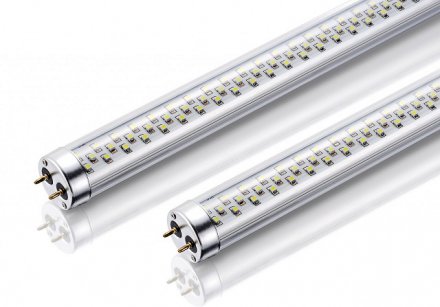LED tubes - cheap solution or disadvantageous purchase??
The market is flooded with LED tube lighting and a lot of resellers preach for its advantages. This often raises expectations that can not be realized

It juggles lifespan, luminous flux and energy savings in such a way that the potential user - you - is completely lost. In brief, we will enumerate the misconceptions and the actual facts of LED tubes for you here.
Misconception 1: Lifetime
It is claimed that LED tubes last longer than fluorescent TL-D lamps. Nonsense, there are TL5 solutions with long life spans and up to 90% lumen maintenance. In particular, the lumen output maintenance at the end of a lamp lifetime is of great importance. And this is lacking in most cases with LED tubes. In addition, the claimed long service life can not be guaranteed. And when one speaks about warranty. this is still very limited (1 or 2 years), compared with the rated life.
Misconception 2: Luminaire adjustments
For an LED tube to function in an existing TL-D luminaire it is recommended that the user should remove or overcome the ballast. This will void any warranty, claim or support of the fixture manufacturers and the accountability is for the end user.
Misconception 3: (Mirror) optics
The light of LED fluorescent lamps does not account for (mirror) optics. TL-D luminaires are usually fitted with high quality (mirror) optics. These ensure that the light spreads to where you need it without troublesome side effects such as reflections and glare. The light emitted from LED tubes does not ensure the proper use of these optics anymore with the the risk of serious reflections and increased glare. This raises the question whether these tubes will meet the current standards for lighting (NEN12464-1) and Occupational Health. This is probably not the case.
Misconception 4: Luminous Flux Comparisons
An LED tube of, for example, 120 cm (the length of a 36W TL-D), provides as much light as a fluorescent TL-D of 36W. How wrong this information really is, becomes clear when one replaces TL-D lamps with LED tubes. Often there is an enormous decrease (50-70%) in light, with the result that the lighting does no longer meet the lighting requirements set by the standards.
Conclusion
At present, LED tubes are no real alternative to a TL-D lamp. Switching from TLD lamps with magnetic ballast to HF ballasts or TL5 lamps with HF ballast (such as T5 adapters) should be considered. If you combine this with intelligent controls, such as PIR detectors and daylight control, you can reach savings of up to 60% without any hassle or very high investments.
